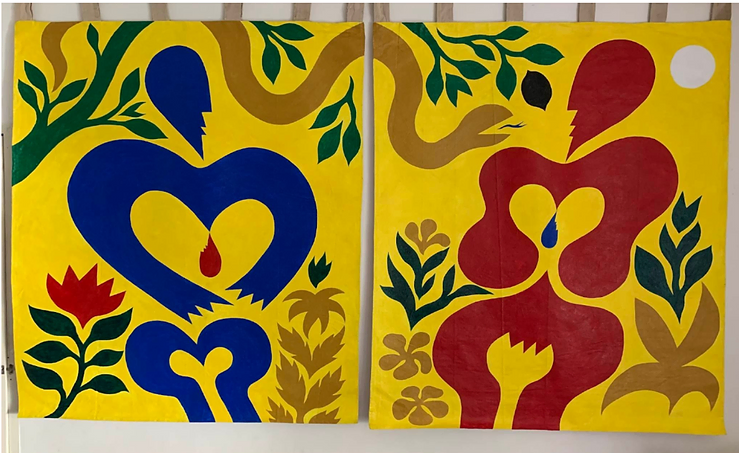Palmy Tudtud
The Frailty of Life and Death

There are countless moments in my life when I feel engulfed under the powerful spell of nature. Its vastness and diversity are overwhelming and being completely immersed in it is a transformative and transcendent experience that fills me with a sense of peace and joy. This connection deepens my appreciation and gratitude for the natural world and my place within it.
As an artist, I am deeply interested in exploring universal themes that affect us all yet are often avoided or denied in society. Art should serve as a means of expressing the deepest truths of human experience because by confronting these realities we can reflect and engage in conversations in a deeper and more meaningful way.
Emmanuel Kant, a great philosopher of the Enlightenment, saw the relationship between art and nature as one of harmony and mutual reinforcement. Nature was the ultimate source of inspiration for art, and art was a way of expressing the artist’s deepest feelings and emotions about the natural world. His theory of aesthetics, particularly his concept of the sublime has had a profound impact on the way many artists understand art and nature. According to Kant, the sublime is a way of accessing the transcendent, the infinite, and the divine. This is not just about appreciating beauty; it is about confronting our limitations and recognizing the complexity and vastness of the world beyond ourselves.
My artwork, “The Frailty of Life and Death” is a series of different pieces: a mixed media painting of a vase of roses in the foreground of a breathtaking sunset, and two wall-bound installation artworks of fresh roses hanging from a dried vine, facing downward towards a mound of earth. The painting hangs at the center of the installation pieces.
These works explore and confront life and death as two concepts that are often deeply intertwined. Alluding to impermanence, everything is in a constant state of change, and nothing lasts forever. This perspective is also associated with mortality, which refers to the finite nature of human life.
The prominent subject in both the painting and installation work is the roses. This has a symbolic meaning of impermanence and transience. Its beauty is fleeting and temporary, and it serves as a reminder that nothing in life is permanent. The thorns symbolize the harsh realities of life, such as pain, suffering, and mortality. Its delicate petals symbolize the balance between life and death, and the ephemeral beauty of existence. Like human life, the life of a rose is finite and fleeting, and its beauty and vibrancy are transitory. Both human life and the life of a rose are subject to the same cycle of birth, growth, decay, and death. This mirrors the life cycle of all living things.
In the painting, the essence of beauty and nature is captured by emphasizing the lush bouquet of roses symmetrically arranged in a cadmium green vase. The roses are in a variety of colors, shapes, and sizes, each with a unique charm. The petals are soft to the touch, and their colors range from oranges and pinks to soft yellows and whites. The roses are juxtaposed against the vast and powerful backdrop of the sunset which fills the canvas with warm and deep hues and dramatic light. The combination of the two elements creates a sense of contrast that is both enchanting and unsettling.
The sunset is an important component of the sublime experience in the painting. Its vivid colors which vary from shades of pink, orange, red, purple, and deep blues, and the dramatic changes in the sky create a sense of excitement and anticipation. It also evokes feelings of peace, tranquility, and gratitude leaving behind the stresses and worries of the day as the sun goes down the horizon. Watching a sunset is a reflective and contemplative one. Its fleeting nature, and the knowledge that it will soon be gone, remind us of the impermanence of life and the importance of savoring each moment. This can be seen as a microcosm of the natural world, with the roses representing the beauty and complexity of nature and the sunset illuminating the blooms representing the transient and fleeting nature of life.
The wall-bound installation represents life and death powerfully and poignantly inviting the viewer to contemplate the fleeting nature of life, the inevitability of death, and the beauty that can be found in the transience of existence. It also creates a sense of confinement and restriction that echoes the limitations of our mortal existence. The downward-facing roses suggest a sense of melancholy and sadness, with the flowers mourning their demise. The use of real, fresh roses in the installation is to create art that is intentionally impermanent and the fleeting nature of life and the beauty that can be found in its impermanence.
As time passes by, the roses wilt and die, with petals, leaves, and stems eventually falling to the ground. Its alluring fragrance fades away leaving behind only the memory of its intoxicating aroma. The decay of a rose is what allows it to give back to the earth, enriching the soil and providing nutrients for new growth. This process highlights the ephemerality of life and the inevitability of death. Viewing the installation from a distance, allows us to look through a window into a fragile world that is both beautiful and tragic. Only our memories of beauty and wonder remain after we are gone.
In conclusion, the relationship between art and nature is a complex and multifaceted one, shaped by many factors. Using visual representations and symbolisms in the mixed media and installation artworks in “The Frailty of Life and Death” was a reflective and contemplative process. It enhanced my appreciation and connection with nature that constantly leaves me breathless and it reconciled my understanding with the dreadful truth – roses and sunsets like life are transitory, and I am only a transient in this natural world I call home.
